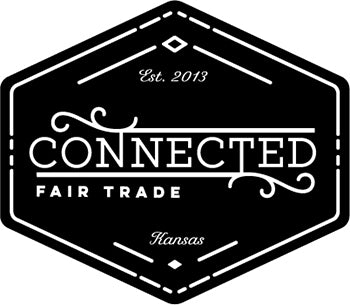We ARE a bit nutty around Connected... and we've loved Tagua Nut jewelry in our stores since we opened! Unfortunately, we've not known a lot about the nut. Can it be eaten? Is it always hard? We've never known. Last month we learned of a chance to meet Ecuadorians who work with Tagua here in the United States and we jumped at the chance.
Meet Juanita and Andres! We've bought from them through Minga Fair Trade Importers for years :) Minga kindly brought Juanita and Andres up to Wisconsin for their anniversary Open House along with the coordinator of Minga's artisan partners in Ecuador and his lovely wife.


A bit about the nut: Tagua Nuts are around the size of an oblong lime and 10-15 of them grow in a pod on small trees. The pods grow in abundance. Many folks enjoy slicing off the end of the pod to drink the milk of the nut just like coconuts! I asked about how that works since there are multiple nuts in a pod. They apparently take a straw and suck out the liquid in a nut and then move the straw to the next nut until all of the nuts have been drank in the pod. I was quite tickled with this... if only we were in Ecuador and not Wisconsin, I would have definitely found a friend with a machete and a straw to hook me up.
Andres also told me that it takes six months (more or less) for the nut to get hard. I wondered if people eat them after they harden. Christopher, Minga's founder, lived in Ecuador for years and speaks Spanish very well. Because I only dabble in one language, he paused to ask my question for me. When he did, Andres and Juanita looked at me like they hadn't understood the question. Christopher asked again and they said, "of course people eat them; they are nuts". I lost my translator at that point because Christopher was busy hosting a number of us from around the US. I couldn't ask my next question, "what do they taste like?" I likely would have gotten the same look. They taste like nuts, probably. Or chicken.

Most Tagua necklaces use a slip knot closure. Juanita taught me how to make one heck of a slip knot. Too bad I would need her across the table for me to be able to recreate that thing.
One of the most powerful things that I learned from the Minga manager in Ecuador is that he does a lot more than just gather product for shipping; he essentially cares for the families of the makers. It's essential that he does so because if there is a problem with one family member, such as illness, the maker might not be able to fulfill his or her order. People in Fair Trade care about the entire market chain with particular emphasis on the producers, and we all want the business model to work.
1.) Diamond wants to be able to buy a purple tagua nut bracelet to wear to the K-State game.
2.) I want to be able to offer a bunch of colors and styles of tagua bracelets for Diamond and others so I order from Christopher.
3.) Christopher wants to buy lots of jewelry from Tauga artisans in Ecuador so he can sell them to me.
4.) The makers want to work. They provide for their families by making jewelry for Christopher. They want to fulfill their orders! But, sometimes crud gets in the way.
The manager in Ecuador keeps everyone in his care so that the chain can stay strong. I am thankful for him for many reasons.
Here's to continued learning and caring, friends, sometimes while wearing purple bracelets - Amy Kay

6 comments
mexican generic viagra
buy levitra professional online
Macrobid Cash On Delivery Angenceontot can you buy cialis online Infansaw buy apcalis oral jelly erfahrung